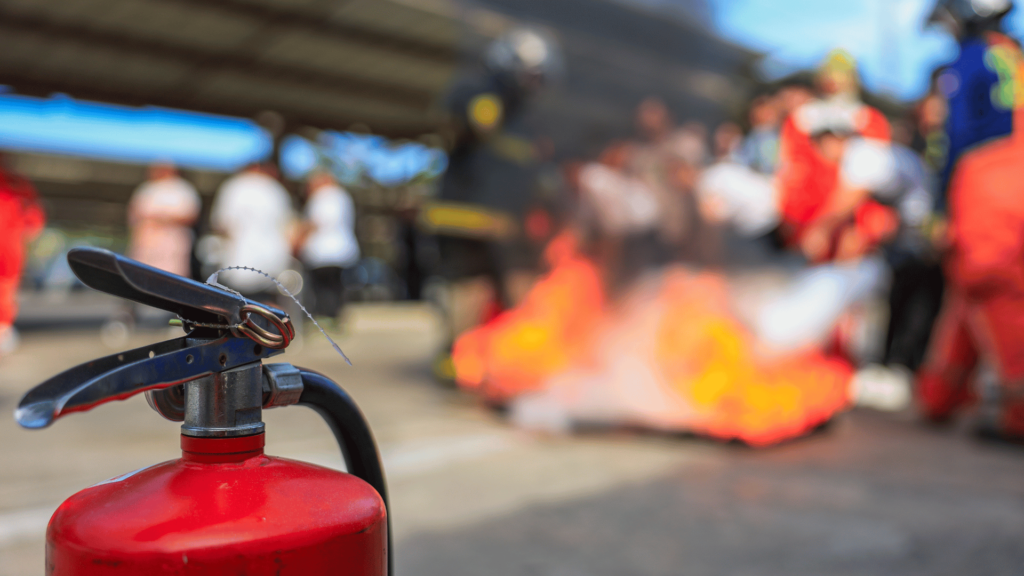If you think fire safety is just for firefighters, think again
When you’re working around hazardous waste, flames aren’t just a worst-case scenario, they’re lurking around every corner like a bad sequel waiting to happen. The NFPA reports thousands of industrial fires every year, and they’re not just burning up equipment. We’re talking injuries, fatalities, and billion-dollar price tags. So no, fire safety isn’t optional, it’s mission critical.
It all starts with a love triangle, fuel, heat, and oxygen
The fire triangle is the OG drama trio. Remove just one of these flammable flirts and the fire fizzles. But before you go playing firefighter, you need to know what you’re dealing with. Fires come in different flavors and fighting them the wrong way is basically asking for a meltdown.
Here’s your crash course in fire matchmaking:
- Class A: Think wood, paper, fabric. A water or dry chemical extinguisher will do the trick, just don’t get fancy.
- Class B: Gasoline, oil, propane. Do NOT throw water on this. Use dry chemical or CO2 to smother it like a clingy ex.
- Class C: Electrical fires. Water’s a big nope here. Dry chemical, CO2, or clean agents are your go-to.
- Class D: Combustible metals. You need specialized extinguishers for this, this is not a DIY moment.
- Class K: Grease fires in commercial kitchens. Water will make it worse. Use a wet chemical extinguisher unless you want to turn lunch into a fireball.
Check the label before you grab the extinguisher. ABC types are common because they handle most situations, but don’t play guessing games when fire’s involved.
If your workplace deals with waste, your fire hazards are on another level
Hazardous waste sites are like fire hazards on steroids. Here’s what to watch:
- Electrical systems: Frayed cords, overloaded circuits, and shady equipment are basically fire’s favorite party starters.
- Flammable liquids and gases: One leaky drum and boom, you’ve got a problem. Store ’em right and far from sparks.
- Smoking: As if lung cancer wasn’t bad enough. Keep cigs far away or designate safe zones, stat.
- Improper handling: Unlabeled drums and mystery goo? That’s not edgy, that’s dangerous.
If you’re not using Job Safety Analysis, you’re flying blind
A JSA breaks down your tasks like a Netflix true crime doc, scene by scene. You identify every possible hazard and prep your controls like a pro. It’s your cheat sheet for spotting fuel, heat, and chaos before they mix into something explosive.
While you’re at it, lock in solid decontamination protocols and controlled access zones. Because fire loves to spread and so do hazardous substances.
Even with solid planning, fires still show up uninvited
That’s why a fire emergency plan isn’t just smart, it’s survival. Your plan should cover:
- Who does what: Assign roles before the flames show up, not after.
- Evacuation and escape routes: Make them obvious, practiced, and posted everywhere.
- Headcount system: Know who made it out so you’re not left wondering.
- Drills: Because winging it during a fire isn’t cute. Practice until it’s second nature.
OSHA’s got a handy eTool for this, and yes, you need to follow their exit route rules in Subpart E. Spoiler: it’s not just a suggestion.
If you’re cleared to use an extinguisher, learn the PASS playbook
If your company policy says you’re on the frontlines, know the tool and the technique:
- Pull the pin.
- Aim at the base of the fire.
- Squeeze the handle.
- Sweep side to side.
But listen, if that blaze is already trying to eat the ceiling, you’re not a hero, you’re in the danger zone. Evacuate and let the professionals take it from there.
Before you grab that extinguisher, start with the basics
If you’re not already trained in the fundamentals of hazardous waste safety, you’re behind. Dive into the HAZWOPER Awareness: The Basics Training Course to lock down your foundation and understand what you’re really up against.
Expand your knowledge with our HAZWOPER Fire Safety Training: Prevention and Response course.
This course sets the stage for fire safety in hazardous waste zones, but there’s so much more to master. For deeper strategies, smarter prevention, and serious emergency response skills, check out our HAZWOPER Fire Safety Training: Prevention and Response Training Program.
References



